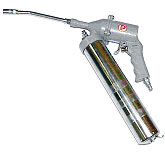Preventing Contamination During Lubrication
 I can remember the first time I was told to grease a bearing. I ask the millwright “How do I know when there is enough grease?”. He responded, ” When you see it come out of the sides of the bearing”… How many of you had this same experience?
I can remember the first time I was told to grease a bearing. I ask the millwright “How do I know when there is enough grease?”. He responded, ” When you see it come out of the sides of the bearing”… How many of you had this same experience?
During this brief instruction, there was no mention of selecting the right grease, preventing contamination, etc. So, with this experience in mind, I wanted to provide what I believe are best practices when using a grease gun. Why do I think there needs to be a review of how to grease with a grease gun? I still see manual lubrication performed with no regard for best practices, and lubrication is still a major contributor to equipment failures.
The grease gun is capable of putting out thousands of PSI when pumping grease, which is more than enough to damage seals and other components. This alone warrants a cautionary approach with them.
Grease Gun Storage Best Practices
Keeping the lubricant and grease gun clean is critical to the preventing contamination. It all starts with proper storage of the equipment.
- Keep grease guns clean and covered when, not in use
- Keep the nozzle covered and clean. If necessary, pump out a small amount of grease before putting in storage so that the nozzle can have wiped quickly and all contaminants removed.
- Keep in climate-controlled area, to prevent moisture contamination
- Use a grease gun with a single lubricant. Do not mix lubricants with grease guns.
- Make sure that the grease in the grease guns is fresh and not old.
Greasing Best Practices
Once the grease gun leaves the shop and is taken into the field to lubricant the equipment, the following should be followed;
- Repack the grease gun in a clean area to prevent contamination
- Pump a small bit of grease and wipe the end clean before starting the lube route. This will ensure there is no contamination transfer from the grease gun.
- Using a clean, lint-free cloth, wipe the grease zerk before connecting the grease gun
- Inspect the grease zerk (and lines where possible) to ensure they are in good condition
- Know how much grease comes out of each gun with a single pump, and apply the right amount of grease
- Do not over lubricate. Follow the recommended amount of grease to replenished.
- Apply a little bit of grease to the outside of zerk once the lubrication is complete. This will prevent contaminants from accumulating on the zerk and will allow the lubricating technician to easily wipe away the grease and contamination the next time greasing is required.
Grease Program Best Practices
To get the most of out the grease program, it is advisable to ensure the following;
- Label or identify each grease zerk, or number of zerk per machine
- Label or identify each grease zerk with the type of lubricant required
- Label or identify each grease zerk with the quantity and frequency of lubrication
- Do not over order lubricants. Keep enough on hand to prevent stock-outs, but not too much where it can become contaminated or expire
Following the simple steps above will improve the effectiveness of the lubrication. These simple steps will prevent contamination, and over/under lubrication of bearings, resulting in reduced premature failures.
Next Steps
Use the above points (and add or remove as needed) to create a Toolbox Talk. Review the Toolbox Talk with your staff and invite questions, concerns, etc. and let them know you expect that these best practices will be followed moving forward.
I would like to know what success and benefits following these simple guidelines bring to your organization. Please email me with the benefits, or if you need any assistance with your lubrication program, please contact [email protected].
I’m James Kovacevic
Principal Instructor at Eruditio
Where Education Meets Application
Follow @EruditioLLC
Follow @ReliableJames
Follow @HPReliability

